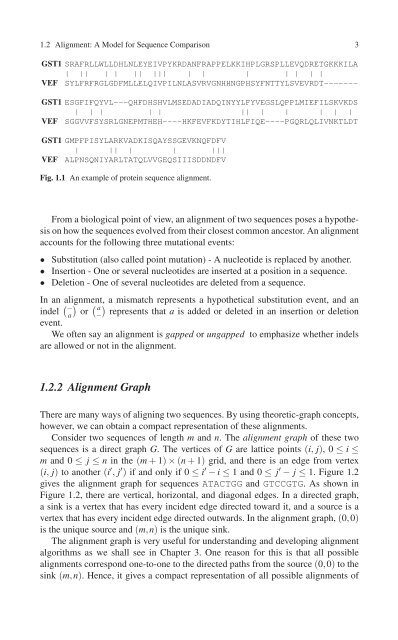You also want an ePaper? Increase the reach of your titles
YUMPU automatically turns print PDFs into web optimized ePapers that Google loves.
1.2 Alignment: A Model for <strong>Sequence</strong> <strong>Comparison</strong> 3<br />
GST1 SRAFRLLWLLDHLNLEYEIVPYKRDANFRAPPELKKIHPLGRSPLLEVQDRETGKKKILA<br />
| || | | || ||| | | | | | | |<br />
VEF SYLFRFRGLGDFMLLELQIVPILNLASVRVGNHHNGPHSYFNTTYLSVEVRDT-------<br />
GST1 ESGFIFQYVL---QHFDHSHVLMSEDADIADQINYYLFYVEGSLQPPLMIEFILSKVKDS<br />
| | | | | || | | | | |<br />
VEF SGGVVFSYSRLGNEPMTHEH----HKFEVFKDYTIHLFIQE----PGQRLQLIVNKTLDT<br />
GST1 GMPFPISYLARKVADKISQAYSSGEVKNQFDFV<br />
| || | | |||<br />
VEF ALPNSQNIYARLTATQLVVGEQSIIISDDNDFV<br />
Fig. 1.1 An example of protein sequence alignment.<br />
From a biological point of view, an alignment of two sequences poses a hypothesis<br />
on how the sequences evolved from their closest common ancestor. An alignment<br />
accounts for the following three mutational events:<br />
• Substitution (also called point mutation) - A nucleotide is replaced by another.<br />
• Insertion - One or several nucleotides are inserted at a position in a sequence.<br />
• Deletion - One of several nucleotides are deleted from a sequence.<br />
In an alignment, a mismatch represents a hypothetical substitution event, and an<br />
indel ( −<br />
(<br />
a)<br />
or<br />
a<br />
−)<br />
represents that a is added or deleted in an insertion or deletion<br />
event.<br />
We often say an alignment is gapped or ungapped to emphasize whether indels<br />
are allowed or not in the alignment.<br />
1.2.2 Alignment Graph<br />
There are many ways of aligning two sequences. By using theoretic-graph concepts,<br />
however, we can obtain a compact representation of these alignments.<br />
Consider two sequences of length m and n. Thealignment graph of these two<br />
sequences is a direct graph G. The vertices of G are lattice points (i, j), 0≤ i ≤<br />
m and 0 ≤ j ≤ n in the (m + 1) × (n + 1) grid, and there is an edge from vertex<br />
(i, j) to another (i ′ , j ′ ) if and only if 0 ≤ i ′ − i ≤ 1 and 0 ≤ j ′ − j ≤ 1. Figure 1.2<br />
gives the alignment graph for sequences ATACTGG and GTCCGTG. Asshownin<br />
Figure 1.2, there are vertical, horizontal, and diagonal edges. In a directed graph,<br />
a sink is a vertex that has every incident edge directed toward it, and a source is a<br />
vertex that has every incident edge directed outwards. In the alignment graph, (0,0)<br />
is the unique source and (m,n) is the unique sink.<br />
The alignment graph is very useful for understanding and developing alignment<br />
algorithms as we shall see in Chapter 3. One reason for this is that all possible<br />
alignments correspond one-to-one to the directed paths from the source (0,0) to the<br />
sink (m,n). Hence, it gives a compact representation of all possible alignments of

















